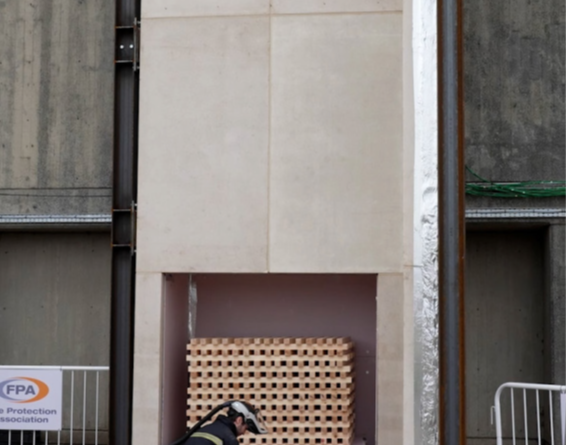MPA Precast successfully completes BS 8414 fire test at the FPA’s cladding test rigs
MPA Precast successfully completes BS 8414 fire test at the FPA’s cladding test rigs
MPA Precast is part of the Mineral Products Association (MPA); the trade association for the aggregates, asphalt, cement, concrete, dimension stone, lime, mortar, and silica sand industries. MPA Precast represents the UK precast concrete manufacturers and members of the supply chain. MPA Precast has successfully completed a BS 8414 fire test, meeting the requirements of BR135, on a single skin precast concrete cladding system at the FPA’s cladding test rigs in Gloucestershire.
When designing buildings, MPA Precast believes that proper regard should be paid to the use of non-combustible materials in order to protect building occupants. Although concrete has been proven to be non-combustible, MPA Precast recognised the importance of demonstrating the safety of concrete products, particularly following the scrutiny placed on the cladding/facades sector since the Grenfell Tower tragedy, and so decided to undertake a BS 8414 test at the FPA.
The FPA is accredited by UKAS to carry out BS 8414 testing which tests the fire performance of external cladding on buildings, and is one of few companies in the UK offering this important British Standard test. As concrete’s inherent non-combustible properties – proven by its A1 reaction to fire classification – mean that conducting large-scale fire tests on concrete facades isn’t always a necessary part of building certification, the MPA Precast test was carried out as a solution demonstration rather than a system certification exercise.
The BS 8414 test
MPA Precast provided 12 concrete cladding panels for the fire test, which was fuelled by one timber crib set alight for 30 minutes. The test method sets out a clear process for testing the behaviour of non-load bearing external cladding, rain screen over cladding, and external wall insulation systems when applied to the face of the building and exposed to an external fire.
The fire exposure is designed to be representative of an external fire source or a fully developed (post-flashover) fire in a room, venting through an opening such as a window aperture that exposes the cladding to the effects of external flames.
The test was assessed against the following criteria:
- External fire spread: The temperature rise recorded from any external thermocouple at level 2 should not exceed 600˚C for a period of at least 30 seconds, within 15 minutes of the start time.
- Internal fire spread: The temperature rise recorded from any internal thermocouple at level 2 should not exceed 600˚C for a period of at least 30 seconds, within 15 minutes of the start time.
- Mechanical performance: No failure criteria are set for mechanical performance. However, ongoing system combustion following extinguishing of the ignition source is included in the test reports, together with details of any system collapse, spalling, delamination, flaming debris or pool fires. The nature of the mechanical performance should be considered as part of the overall risk assessment when specifying the system.
MPA Precast’s system was tested to the full duration and upon completion of the test, the concrete panels were still structurally sound, displaying only limited cosmetic damage to their surfaces which is testament to their fire resistance performance.
Tony Jones, Technical Director at The Concrete Centre said: “As a non-combustible material, concrete is the low-risk solution as it doesn’t contribute to fire. This means it doesn’t burn, it doesn’t give off toxic fumes, and it doesn’t give off smoke. You don’t have to test concrete to know it is non-combustible, but we felt it was important to give people the confidence that concrete facades wouldn’t contribute to the spread of fire across buildings. The test itself effectively tries to represent what would happen in a fire breaking out of a window or other major opening within a façade. The results should give peace of mind to owners in that the damage was limited; to occupiers of buildings in that the fire didn’t spread; and to insurers because it is relatively easy to repair and get the building back into working condition. Using concrete to protect against fire is a responsible design decision.”
MPA Precast’s successful full-scale fire test to the rigorous BS 8414 standard demonstrates that the concrete cladding system met the requirements for external and internal fire spread specified in BR 135. The test results showed that the precast concrete façade system not only prevented external fire spread up the front of the panels, but also prevented fire spread into the cavity or insulation layers in the test conducted.
George Edwardes, Technical Steering Group Manager at the FPA said: “At the FPA, we have long been advocates of non-combustible construction as a means of preventing devastating fires in vulnerable settings like care homes, schools, and hotels. Non-combustible construction greatly reduces the risk of fire and its catastrophic consequences, while also eliminating much of the risk associated with human error in the design and construction phases. When buildings are constructed with combustible materials, even small errors in design or installation can have disastrous consequences. It’s crucial that the built environment reflects the risks it’s protecting against, and non-combustible products are one of the ways of achieving this.”
Find out more about the FPA’s UKAS accredited BS 8414 cladding testing.

